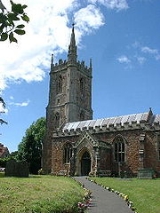
St Andrew's Church, Chew Stoke
Encyclopedia
St Andrews Church of the Church of England
, is on the outskirts of Chew Stoke
, Somerset
, England
.
The Parish of Chew Stoke is within the Benefice
of Chew Stoke with Nempnett Thrubwell
and forms part of the Diocese of Bath and Wells
.
The church, parts of which date from the 15th century, is a Grade II* listed building.
es and a paneled parapet
on the west tower which has an unusual spirelet on the staircase turret
, and contains bells
cast by the Bilbie family in the village.
The tower, which was built around 1475, has an ornate crown with an elaborate spirelet over the stair turret with two tiers of arcading.
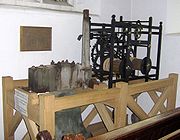 The oldest bell in the tower dates from 1698 and was cast by the Bilbie family in the village. Others from the same maker are dated 1718 and 1731. The bells were tuned and re-hung into anew frame in 1908 and again in 1996 with a new bell from John Taylor's foundry
The oldest bell in the tower dates from 1698 and was cast by the Bilbie family in the village. Others from the same maker are dated 1718 and 1731. The bells were tuned and re-hung into anew frame in 1908 and again in 1996 with a new bell from John Taylor's foundry
in Loughborough replacing the treble. The redundant bell is now on display at the back of the church as a memorial to the Bilbies.
 The Victorian
The Victorian
square font
and pulpit
match, but are now largely whitewash
ed, as is much of the rest of the church. Just inside the porch, on the left of the church door, is a stone figure holding an anchor which was moved to the church from Walley Court with the flooding of the lake. There is an unconfirmed story that this was given to the Gilbert family, then living at the court by Queen Elizabeth I
. It is possible that it was originally from the site of a nunnery within the parish which was closed with the dissolution of the monasteries
in 1536.
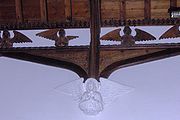 The inside of the church is decorated with 156 angel
The inside of the church is decorated with 156 angel
s in wood and stone. One of the wooden angels has a broken wing and various stories are suggested as a cause for this.
It also contains a bronze
plaque
commemorating the eleven people from the village who died in World War I
and six from World War II
.
There is also a stained glass
window showing a saint with a sword standing on a snake and crossed flags, commemorating those from World War II. Several other stained glass windows date from the Victorian era
. The window in the tower was donated by a London goldsmith named Mattheson to commemorate the rebuilding of the church in 1863. The east window represents events in the life of Saint Andrew
.
There are three wooden chests, two of which date from the 20th century, but the oldest is probably from the 16th century and was a "poor man's chest." These were common in English parishes following the decree by Queen Elizabeth I that each parish provide a strong chest with three keys to keep safe custody of alms for the poor.
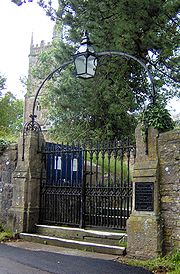 In the churchyard is the reconstructed Moreton Cross which was moved here when Chew Valley Lake
In the churchyard is the reconstructed Moreton Cross which was moved here when Chew Valley Lake
was flooded.
The base of a cross shaft in the churchyard, about 24 metres south west of the tower, is thought to date from the 14th century and is a Grade II* listed building, as is the Webb monument in the churchyard. The churchyard gate, at the southeast entrance, bears a lamp which was provided by public subscription to commemorate Queen Victoria
's Jubilee of 1897, itself a Grade II listed structure.
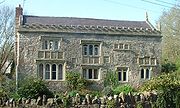 The village hall is at the end of Church Lane, opposite the rectory
The village hall is at the end of Church Lane, opposite the rectory
which is believed to have been built in 1529 by the rector, Sir John Barry, (Rector 1524–46). It has undergone substantial renovations including the addition of a clock tower
for the Rev. W.P. Wait, which has since been removed and further alterations c.1876 for Rev. J. Ellershaw. The building has an ornate south front with carvings of shields bearing the coat of arms of the St Loe family, who were once chief landowners in the area, alone or impaled with arms of Fitzpane, Ancell, de la Rivere and Malet. It is Grade II* listed.
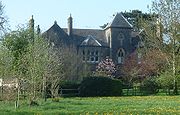 The new rectory was built by the Reverend John Ellershaw in the 1870s. The last rector to occupy it was Lionel St. Clair Waldy from 1907 to 1945. It was then bought by Douglas Wills who donated it and the rectory field to Winford
The new rectory was built by the Reverend John Ellershaw in the 1870s. The last rector to occupy it was Lionel St. Clair Waldy from 1907 to 1945. It was then bought by Douglas Wills who donated it and the rectory field to Winford
Hospital as a convalescent home for 16 children, and later used as a nurses home before being sold for private use. It is now split into several residential units.
Church of England
The Church of England is the officially established Christian church in England and the Mother Church of the worldwide Anglican Communion. The church considers itself within the tradition of Western Christianity and dates its formal establishment principally to the mission to England by St...
, is on the outskirts of Chew Stoke
Chew Stoke
Chew Stoke is a small village and civil parish in the Chew Valley, in Somerset, England, about south of Bristol. It is at the northern edge of the Mendip Hills, a region designated by the United Kingdom as an Area of Outstanding Natural Beauty, and is within the Bristol/Bath green belt...
, Somerset
Somerset
The ceremonial and non-metropolitan county of Somerset in South West England borders Bristol and Gloucestershire to the north, Wiltshire to the east, Dorset to the south-east, and Devon to the south-west. It is partly bounded to the north and west by the Bristol Channel and the estuary of the...
, England
England
England is a country that is part of the United Kingdom. It shares land borders with Scotland to the north and Wales to the west; the Irish Sea is to the north west, the Celtic Sea to the south west, with the North Sea to the east and the English Channel to the south separating it from continental...
.
The Parish of Chew Stoke is within the Benefice
Benefice
A benefice is a reward received in exchange for services rendered and as a retainer for future services. The term is now almost obsolete.-Church of England:...
of Chew Stoke with Nempnett Thrubwell
Nempnett Thrubwell
Nempnett Thrubwell is a small village and civil parish in dairying country on the western edge of Bath and North East Somerset, in the county of Somerset, England. It is about 15 km south-west of Bristol. The parish, which has a population of 189, is sheltered by the Mendip Hills, near the River...
and forms part of the Diocese of Bath and Wells
Diocese of Bath and Wells
The Diocese of Bath and Wells is a diocese in the Church of England Province of Canterbury in England.The diocese covers the county of Somerset and a small area of Dorset. The Episcopal seat of the Bishop of Bath and Wells is located in the Cathedral Church of Saint Andrew in the tiny city of...
.
The church, parts of which date from the 15th century, is a Grade II* listed building.
Architecture
The church was constructed in the 15th century in the perpendicular style and the tower remains largely unchanged, however the main body underwent extensive renovation and the addition of the north isle in 1862. It has diagonal buttressButtress
A buttress is an architectural structure built against or projecting from a wall which serves to support or reinforce the wall...
es and a paneled parapet
Parapet
A parapet is a wall-like barrier at the edge of a roof, terrace, balcony or other structure. Where extending above a roof, it may simply be the portion of an exterior wall that continues above the line of the roof surface, or may be a continuation of a vertical feature beneath the roof such as a...
on the west tower which has an unusual spirelet on the staircase turret
Turret
In architecture, a turret is a small tower that projects vertically from the wall of a building such as a medieval castle. Turrets were used to provide a projecting defensive position allowing covering fire to the adjacent wall in the days of military fortification...
, and contains bells
Church bell
A church bell is a bell which is rung in a church either to signify the hour or the time for worshippers to go to church, perhaps to attend a wedding, funeral, or other service...
cast by the Bilbie family in the village.
The tower, which was built around 1475, has an ornate crown with an elaborate spirelet over the stair turret with two tiers of arcading.
Bells

John Taylor Bellfounders
John Taylor & Co, formerly trading as Taylors, Eayre & Smith Ltd and John Taylor Bellfounders Ltd, and commonly known as Taylor's Bell Foundry or simply Taylor's, is the world's largest working bell foundry, located in Loughborough in the United Kingdom.The company manufactures bells for use in...
in Loughborough replacing the treble. The redundant bell is now on display at the back of the church as a memorial to the Bilbies.
| Bell Number | Founder | Date |
|---|---|---|
| Treble | John Taylor John Taylor Bellfounders John Taylor & Co, formerly trading as Taylors, Eayre & Smith Ltd and John Taylor Bellfounders Ltd, and commonly known as Taylor's Bell Foundry or simply Taylor's, is the world's largest working bell foundry, located in Loughborough in the United Kingdom.The company manufactures bells for use in... |
1996 |
| 2 | Bilbie | 1731 |
| 3 | Bilbie | 1718 |
| 4 | T Mears | 1820 |
| 5 | Bilbie | 1698 |
| Tenor | Llewelyn and James | 1876 |
Church interior

Victorian era
The Victorian era of British history was the period of Queen Victoria's reign from 20 June 1837 until her death on 22 January 1901. It was a long period of peace, prosperity, refined sensibilities and national self-confidence...
square font
Baptismal font
A baptismal font is an article of church furniture or a fixture used for the baptism of children and adults.-Aspersion and affusion fonts:...
and pulpit
Pulpit
Pulpit is a speakers' stand in a church. In many Christian churches, there are two speakers' stands at the front of the church. Typically, the one on the left is called the pulpit...
match, but are now largely whitewash
Whitewash
Whitewash, or calcimine, kalsomine, calsomine, or lime paint is a very low-cost type of paint made from slaked lime and chalk . Various other additives are also used...
ed, as is much of the rest of the church. Just inside the porch, on the left of the church door, is a stone figure holding an anchor which was moved to the church from Walley Court with the flooding of the lake. There is an unconfirmed story that this was given to the Gilbert family, then living at the court by Queen Elizabeth I
Elizabeth I of England
Elizabeth I was queen regnant of England and Ireland from 17 November 1558 until her death. Sometimes called The Virgin Queen, Gloriana, or Good Queen Bess, Elizabeth was the fifth and last monarch of the Tudor dynasty...
. It is possible that it was originally from the site of a nunnery within the parish which was closed with the dissolution of the monasteries
Dissolution of the Monasteries
The Dissolution of the Monasteries, sometimes referred to as the Suppression of the Monasteries, was the set of administrative and legal processes between 1536 and 1541 by which Henry VIII disbanded monasteries, priories, convents and friaries in England, Wales and Ireland; appropriated their...
in 1536.

Angel
Angels are mythical beings often depicted as messengers of God in the Hebrew and Christian Bibles along with the Quran. The English word angel is derived from the Greek ἄγγελος, a translation of in the Hebrew Bible ; a similar term, ملائكة , is used in the Qur'an...
s in wood and stone. One of the wooden angels has a broken wing and various stories are suggested as a cause for this.
It also contains a bronze
Bronze
Bronze is a metal alloy consisting primarily of copper, usually with tin as the main additive. It is hard and brittle, and it was particularly significant in antiquity, so much so that the Bronze Age was named after the metal...
plaque
Commemorative plaque
A commemorative plaque, or simply plaque, is a plate of metal, ceramic, stone, wood, or other material, typically attached to a wall, stone, or other vertical surface, and bearing text in memory of an important figure or event...
commemorating the eleven people from the village who died in World War I
World War I
World War I , which was predominantly called the World War or the Great War from its occurrence until 1939, and the First World War or World War I thereafter, was a major war centred in Europe that began on 28 July 1914 and lasted until 11 November 1918...
and six from World War II
World War II
World War II, or the Second World War , was a global conflict lasting from 1939 to 1945, involving most of the world's nations—including all of the great powers—eventually forming two opposing military alliances: the Allies and the Axis...
.
There is also a stained glass
Stained glass
The term stained glass can refer to coloured glass as a material or to works produced from it. Throughout its thousand-year history, the term has been applied almost exclusively to the windows of churches and other significant buildings...
window showing a saint with a sword standing on a snake and crossed flags, commemorating those from World War II. Several other stained glass windows date from the Victorian era
Victorian era
The Victorian era of British history was the period of Queen Victoria's reign from 20 June 1837 until her death on 22 January 1901. It was a long period of peace, prosperity, refined sensibilities and national self-confidence...
. The window in the tower was donated by a London goldsmith named Mattheson to commemorate the rebuilding of the church in 1863. The east window represents events in the life of Saint Andrew
Saint Andrew
Saint Andrew , called in the Orthodox tradition Prōtoklētos, or the First-called, is a Christian Apostle and the brother of Saint Peter. The name "Andrew" , like other Greek names, appears to have been common among the Jews from the 3rd or 2nd century BC. No Hebrew or Aramaic name is recorded for him...
.
There are three wooden chests, two of which date from the 20th century, but the oldest is probably from the 16th century and was a "poor man's chest." These were common in English parishes following the decree by Queen Elizabeth I that each parish provide a strong chest with three keys to keep safe custody of alms for the poor.
Churchyard memorials

Chew Valley Lake
Chew Valley Lake is a large reservoir in the Chew Valley, Somerset, England, and the fifth-largest artificial lake in the United Kingdom , with an area of 1,200 acres...
was flooded.
The base of a cross shaft in the churchyard, about 24 metres south west of the tower, is thought to date from the 14th century and is a Grade II* listed building, as is the Webb monument in the churchyard. The churchyard gate, at the southeast entrance, bears a lamp which was provided by public subscription to commemorate Queen Victoria
Victoria of the United Kingdom
Victoria was the monarch of the United Kingdom of Great Britain and Ireland from 20 June 1837 until her death. From 1 May 1876, she used the additional title of Empress of India....
's Jubilee of 1897, itself a Grade II listed structure.
Rectory

Rectory
A rectory is the residence, or former residence, of a rector, most often a Christian cleric, but in some cases an academic rector or other person with that title...
which is believed to have been built in 1529 by the rector, Sir John Barry, (Rector 1524–46). It has undergone substantial renovations including the addition of a clock tower
Clock tower
A clock tower is a tower specifically built with one or more clock faces. Clock towers can be either freestanding or part of a church or municipal building such as a town hall. Some clock towers are not true clock towers having had their clock faces added to an already existing building...
for the Rev. W.P. Wait, which has since been removed and further alterations c.1876 for Rev. J. Ellershaw. The building has an ornate south front with carvings of shields bearing the coat of arms of the St Loe family, who were once chief landowners in the area, alone or impaled with arms of Fitzpane, Ancell, de la Rivere and Malet. It is Grade II* listed.
New rectory

Winford
Winford is a small village and civil parish within the Chew Valley, Somerset, England. It is within the unitary authority of North Somerset about south of Bristol...
Hospital as a convalescent home for 16 children, and later used as a nurses home before being sold for private use. It is now split into several residential units.

